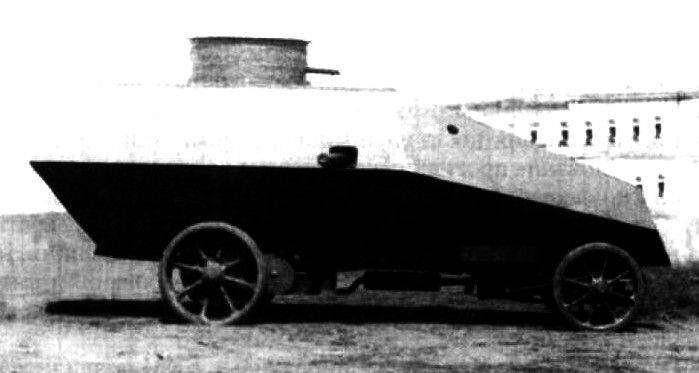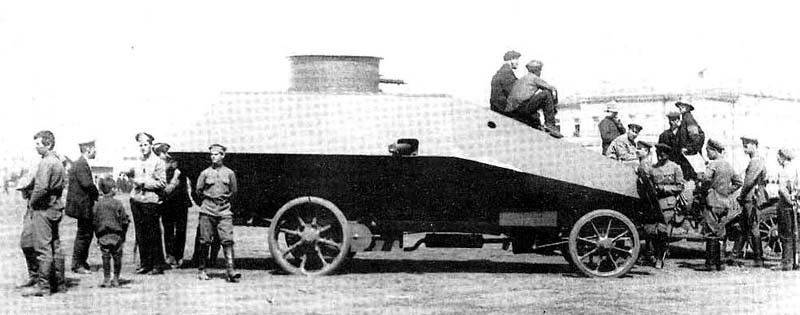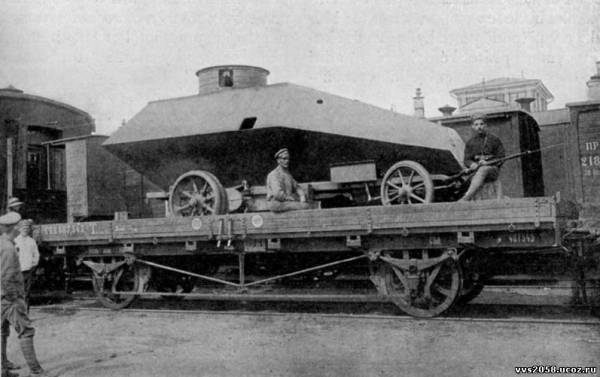Bronedrezina "Benz": the firstborn with a difficult fate
The actual reason for the appearance of the first Russian armored rubber was the plans for the development of the railway in the Far East. In 1908, the construction of the railway to Khabarovsk was launched, with the help of which it was planned to increase the volume of freight traffic in the region. Quickly enough, construction workers had to face an unexpected problem. The construction site was often attacked by Chinese hunhuzy robbers. Such attacks interfered with work, and also led to the death of people and disruption of time. Required a means of protecting workers and newly built paths.
The management of the Amur Railway, which was responsible for the construction of the new highway, in 1911 year decided to order a combat vehicle, which was planned to be used to protect the construction and the already completed hauls. The Russian branch of the German company Benz was chosen as a contractor. In October, 11-th railroad workers formulated the requirements for a promising armored vehicle, and a month later they signed a contract for its development and construction.

General view of armored rubber "Benz"
According to some sources, the requirements for the new armored rubber were as follows. A machine weighing about 120 pounds (1,92 t) was to be equipped with anti-bullet armor 4,5 mm thick and an HP 35-40 engine. It was proposed to take the chassis of an existing truck as a basis for armored tires. Inside the armored hull it was necessary to provide space for six people or cargo weighing up to 20 pounds (320 kg). For self-defense the car had to carry a rotating turret with a machine gun. The maximum speed at full payload should have reached 20 versts per hour (about 21,3 km / h).
About a month passed between the completion of the formation of requirements for a new car and the signing of a development contract. There is reason to believe that during this time the Benz specialists conducted an analysis of the requirements and developed a draft version of the project. The customer, in turn, studied the proposal of the contractor, after which the contract was signed. Full-fledged work on the creation of promising bronedreziny started in the middle of November 1911.
It should be noted, the car is very expensive cost the Amur railway. According to the contract, the contractor was to receive 11500 rubles - many times more than the cost of any of the domestic armored cars of the time. Historians often compare the design of the Benz car with the armored vehicle of the design of Ensign Vonlyarlyarsky created in 1915. The construction of this armored car, which has become the most expensive representative of its class in our country, cost 5900 rubles - almost half as much as assembling a single armored tire.
Design work and the construction of armored vehicles continued until the middle of next year. The Benz Gaggenau bus, which was built in series and supplied to various customers, was chosen as the basis for the railcar. The base case and a number of related equipment were removed from the base chassis. Instead, it was planned to install a new armored corps. The level of technology that existed at that time affected the hull design: it was proposed to install 4,5 mm thick armor sheets on the frame.
The base car had a wheel formula 4х2 and a standard design for those years. All main chassis units were mounted on a rectangular frame. Chassis used leaf springs on both axles. All four wheels had a wooden structure with knitting. The front wheels were single, the rear wheels were gable. Apparently, in the future, for operation on the railway, the car had to get the appropriate wheels. At the same time, the original wheels provided the ability to move on roads. As a result, small and not too complicated work on the replacement of wheels allowed to “change” the car in accordance with the current situation.
The layout of the base bus and armored rubber on its base was standard. In front of the frame was installed Benz gasoline engine Benz 40 horsepower. Behind him was a gearbox and other mechanical transmission units that transmitted torque to the rear wheels. The front axle was not leading, but had control mechanisms that remained from the base bus. Steering should be used when driving on the road. In the railway configuration of the machine, the steering wheel, for obvious reasons, lost its function.
On the chassis it was proposed to mount the armor case of the original form. Trying to provide the required level of protection while maintaining a low mass, the authors of the project developed an armored hull with unusual contours, which even now look bold and original. The lower part of the hull was made of one large-size panel mounted at an angle to the vertical. Two such sheets, divorced to the sides, formed the curved bottom of the body. Between them, apparently, there was a rectangular bottom. The front sheet of the hull was relatively small and had a hexagonal shape. The lower lateral ribs he connected to the sides.
The forehead of the case had three upper parts mounted at an angle to each other. The central part was located with an inclination forward, lateral - forward and to the sides. Similarly, the upper part of the sides and the roof were arranged, but the latter was located strictly horizontally, and the side sections of the parts of the sides were parallel to it. The stern of the hull consisted of two sheets. On the roof of the case was provided epaulet for installing a turret with machine-gun armament.

The surviving photographs of the Benz armored rubber do not allow us to speak with confidence about the door or the hatch for getting inside the crew compartment. They were probably located in the stern or on the port side. The driver had to follow the road with two round holes in the lateral front sheets. According to some information, there was also a viewing hatch in the central front plate.
In front of the rectangular side plates embrasures were provided with devices for mounting machine guns. With their help, it was proposed to control and fire targets in the side sectors. Thus, the armored car could carry three Maxim machine guns: one in the turret and two in the onboard embrasures.
Exact information about the layout of the internal volumes of the armored hull are absent. With confidence, you can only talk about the location in front of the engine housing and control station. Probably, behind the driver there were seats for passengers. In addition, a place was provided for the shooter who ran the turret machine gun.
According to some data, the specialists of the Russian branch of the company were engaged in the development of the Benz bronzed rubber project. The assembly of the machine, in turn, was carried out by a German plant. The construction of the armored vehicle ended in the middle of the 1912 year. In early August, she was taken to St. Petersburg, from where she was sent to Khabarovsk, on a railway platform, to her future duty station.
An interesting fact is that the Russian and German engineers managed to develop a new project in a few months, but still could not cope with the fulfillment of all the requirements. For some unknown reasons, the sample sent to Russia did not have a turret with a machine gun, and was also equipped with wheels of the wrong size. All these shortcomings had to be corrected by Russian specialists. For the contractor, such features of the built-in armor rubber turned into a fine of RUR 1203 withheld from payment of the order.
The presented armored car, referred to in the documents as the “Benz” bus, went to the duty station by the autumn of 1912. The design of the undercarriage made it possible to move both by road and by rail. However, due to the insufficient development of roads in the Far East, the armored car soon received railway wheels, which affected its further operation. Over the next few months, the car went through the whole complex of tests and began a full-fledged service to protect railway workers from gang attacks.
Details of the operation of armored rubber Benz at the Far Eastern construction site are not available. Probably, the armor and machine-gun armament allowed the crew to stop the Hunhuz attacks and put them to flight, wounding or killing attackers. In addition, the car could be used for the transport of important goods and construction managers. In this case, however, the operation of the machine could not be called intensive. It is known that before October 1914 of the Year “The Bus” took a total of 2425 versts (approximately 2587 km) - about 100 versts (108 km) per month. It turns out that most of the time the armored rubber was idle at the stations.
In early October, 1914, a few months after the outbreak of the First World War, the Benz armored tires were transferred to the army as part of the execution of the so-called. military automotive service. This machine, like hundreds of others, was planned to be sent to the front and used in the interests of the current army. Soon after completing all the necessary documents, the armored car was taken to the front by rail.
Bronedrezina "Benz" did not get to the army. Somewhere in the Urals, there was a certain accident, because of which she was not taken to the front. Most likely, during the transportation the armored car received some damage that did not allow it to be used by the troops. The car was unloaded at one of the stations, after which no one remembered it in the next few years.

Armored tires "Benz" in 1918 year
The following references to the Benz bronedresina refer to the beginning of 1918 of the year. According to this information, at the beginning of the Civil War, the armored car belonged to one of the “Red” units that fought in the Perm area. Red Army soldiers exploited this car until June of the same year, after which it became the enemy's trophy. According to other sources, until June 1918, the location of the armored car remained unknown. According to this version, in the middle of 18, “whites” found a car in Omsk and put it into service. Also some sources mention the use of armored rubber Benz by the troops of the Czechoslovak Corps.
All versions of the battle route of the “Blind Bus” agree that since the middle of 1918, it belonged to the White movement and was used on the Eastern front of the Civil War. Details of the operation of the machine by both parties to the conflict are missing.
The last mention of the Benz armored vehicle in the sources dates back to the middle of the 1918 year, when it went to the White Guards. Her further fate remains unknown. Probably armored rubber for some time used for its intended purpose, after which it was destroyed during the fighting. The exact place of death of the car, if it really destroyed, is unknown.
As you can see, the first domestic armored rubber had a very interesting design and, probably, could show itself from the best side. However, her fate was difficult and ambiguous. Operation on the railway, for which the armored car was built, was short-lived and did not differ in high activity. As for the First World War, the Benz armored rubber vehicle simply did not get to the front. Finally, its participation in the Civil War is known only by a few small and ambiguous references. However, the “Benz bus” bus, built in 1912, remained in the domestic stories as the first armored rubber, exploited in our country.
Based on:
http://nt-magazine.ru/
http://aviarmor.net/
http://timyan-omsk.livejournal.com/
Baryatinsky MB, Kolomiets M.V. Armored cars of the Russian army 1906 – 1917 - M .: Technics-youth, 2000
Information